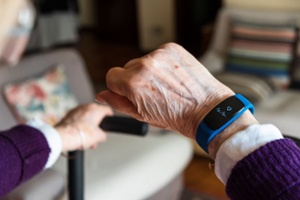The market landscape for aging in place has experienced a significant shift in recent years, driven by advancements in technology and changing preferences among older adults. Aging in place refers to the ability of seniors to live independently and comfortably in their own homes or communities as they grow older, rather than relocating to assisted living facilities or nursing homes. For some, this might even mean moving in with a family member or close friend.
According to a study titled "Aging in Place: Are We Prepared?" by the Delaware Journal of Public Health published by the NIH, 77% of adults over the age of 50 prefer to age in place. Shockingly, in 2020, only 1.2 million adults over 65 were residents in a nursing home. This approach emphasizes maintaining autonomy and quality of life for seniors while addressing their evolving healthcare and support needs. According to an article published by Forbes Health, the top reasons seniors in the U.S. wish to age in place include:
This dynamic initiative presents both challenges and opportunities for stakeholders seeking to provide comprehensive and sustainable solutions to support seniors in their desire to age in place gracefully and securely.
 Aging in place offers many benefits for seniors – including physical, emotional, and social well-being. First, it allows older adults to maintain a sense of familiarity and independence by staying in their own homes or communities, which can contribute to a greater sense of identity, security, and comfort. According to a journal article by The International Journal of Environment Research and Public Health, research suggests that higher satisfaction with an individual’s social structure is directly correlated with decreased feelings of loneliness, depression, and isolation.
Aging in place offers many benefits for seniors – including physical, emotional, and social well-being. First, it allows older adults to maintain a sense of familiarity and independence by staying in their own homes or communities, which can contribute to a greater sense of identity, security, and comfort. According to a journal article by The International Journal of Environment Research and Public Health, research suggests that higher satisfaction with an individual’s social structure is directly correlated with decreased feelings of loneliness, depression, and isolation.
This course of action creates a higher quality of life by empowering seniors to have control over their daily routines, preferences, and lifestyle choices.
From a financial standpoint, aging in place can also be more cost-effective than relocating to assisted living facilities or nursing homes, as it eliminates or reduces expenses associated with institutional care.
While the aging in place movement provides many opportunities for independence, there are also barriers to consider for seniors choosing to remain in their homes. Aging in place often creates a higher quality of one’s social life; however, the opposite can be true. Having a lackluster number of healthy relationships and friendships can lead to increased social isolation and loneliness. Ensuring a faithful social circle is present is paramount to the consideration of aging in place for seniors.
Another significant challenge is the potential decline in physical health and mobility that often accompanies aging, which can make it difficult for seniors to safely navigate and manage their homes. It may be necessary to make modifications to support safety and security, such as zero-step entryways, wheelchair accessible doorways and halls, and installing grab bars. According to the study Aging in Place: Are We Prepared?, a 2020 report estimated that only 10% of American homes are “aging ready,” with a step-free entryway, a bedroom and bathroom on the first floor, and at least one bathroom accessibility feature.
Lastly, the majority of older adults live with a chronic health condition that requires outside care. In fact, according to a study conducted by the CDC, 78 percent of adults over the age of 55 have chronic illnesses such as cancer, cardiovascular disease, or diabetes. This percentage increases to 85 percent after the age 65. Coordinating medical care, managing chronic conditions, and accessing transportation for appointments can be particularly challenging for those living independently.
For more statistics on aging in place independence, check out the AARP survey, “Home and Community Preferences” survey here.
Fortunately, in today’s technology landscape, there are several cutting-edge devices that have emerged as invaluable assets to supporting this dynamic. Some of the top technologies include:
Video Doorbells
Home Monitoring Systems
Medical Smart Watches, such as Apple Watches or FitBits
Fire Prevention Devices
Telehealth Platforms
Video doorbells and outdoor cameras enable residents to manage who comes onto their property via the smartphone app, allowing seniors to avoid getting up to answer the door and increasing personal security. Smart home monitoring devices equipped with voice-controlled assistants, motion sensors, and automated lighting systems can help seniors manage household tasks more efficiently and safely. Wearable health trackers, such as smart watches, enable seniors to monitor vital signs and participate in virtual exercise programs.
 Additionally, smart watches with cellular connectivity and GPS capabilities such as Apple, allow seniors to call loved ones or an emergency line if anything goes wrong. According to an article by Fortune, roughly 28 percent of 65 and older report falling each year. Telehealth platforms facilitate remote consultations with healthcare professionals, allowing seniors to receive medical care and monitoring from the comfort of their homes.
Additionally, smart watches with cellular connectivity and GPS capabilities such as Apple, allow seniors to call loved ones or an emergency line if anything goes wrong. According to an article by Fortune, roughly 28 percent of 65 and older report falling each year. Telehealth platforms facilitate remote consultations with healthcare professionals, allowing seniors to receive medical care and monitoring from the comfort of their homes.
Older adults can often face obstacles to using online services and connected technologies. During the COVID-19 pandemic, this became especially evident as many resources, including healthcare, rapidly shifted online. According to the Older Adults Technology Services from AARP, it was estimated that roughly 40 percent of older adults were not able to access imperative online services from their homes.
There are three major reasons why older adults do not have reliable Internet at home.
Connected healthcare and telehealth providers need to start moving from Bluetooth only technologies, to cellular. Cellular connectivity offers several advantages, including broader coverage, greater mobility, and enhanced reliability. And most importantly for older adults, there is no need to connect to a Wi-Fi network.
As cellular technology continues to evolve and become more accessible, its integration into aging in place solutions is positioned to further improve the quality of life and quality of care for older adults choosing to age in place.


